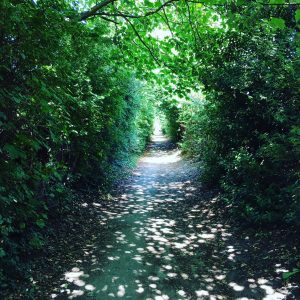Anxiety and taking Yoga off the mat

It was fantastic to see my blog about how yoga helped reduce anxiety during my experience of cervical cancer published in the BWY Spectrum Magazine. Coincidentally, the publication arrived the week before my annual check- up. Because of this synchronicity I decided to revisit the theme of my original blog.
For the first time, the check- up also included a mammogram which was a new source of anxiety. In preparation for my appointment I designed a self -practice to ground and re assure using pranayama and mudra. My intention was to maintain a sense of internal equilibrium and support.
On my way into the hospital I did feel grounded, and maintained a sense of lightness even while checking into reception. However, during the procedure I was surprised when the technician conducting the mammogram remarked kindly ‘You are not breathing’. But I am a yoga teacher, I thought to myself, how could I have not noticed that?
Somewhat chagrined I returned to the waiting room. Although I was shaken, the technician’s observation freshly reminded me of the need to be present in our bodies. In moments of anxiety our bodies suffer, sometimes without us even realizing it. This can be as simple as withholding the breath. We forget how sensitive and reactive our bodies are to our emotions and environment. Of course, when our body suffers our mind will too, further amplifying the stress response.
If we can retrieve our awareness from the drama in our mind and allow it to settle into the body we will notice it’s discomfort and perhaps be able to ease it. This becomes a form of compassion and self- care. The simplest way I have found to do this is to lay my hands on my abdomen and feel them rise and fall with the breath.
This type of breath awareness is something which we become very familiar with during our yoga classes, particularly when in relaxation. But yoga is not meant to be lived only on the mat. As a ‘skill in action’ yoga is meant to help us live better overall. It is during moments of acute anxiety and challenge that the simple practices we learn, such as the abdominal breath, may become very difficult. However, each time we are challenged in this way our skill is honed, increasing our awareness and resilience.
This was an important reminder that I still (and will always) have practice to do, however, the mammogram had further lessons for me. The next day I received a ‘call back’. A ‘density’ had appeared on the scan which required ‘extra views’. The following morning, I found myself back in the same waiting room.
As I sat in the waiting room, mindfully anchored to my abdominal breath, the second scan also returned as inconclusive; my sense of grounding began to dissolve. My mind was pulled from my body into memories of my previous cancer diagnosis, which had begun with an inconclusive smear result.
As I remained seated and waiting to be called in for my third scan, this time an ultrasound, it was clear that the anxious thoughts looping through my mind would not still. However, during these painful moments another form of calm arose. It began with the practice watching my thoughts as they emerged, a skill which we learn during our meditation or conscious relaxation practice. This brought feeling of mental space amid an increasingly fraught experience.
As I continued to watch my thoughts I began to witness their emotional textures also as though an observer. Not only did this sense of space help to partially insulate me from the painful thoughts it also restored a sense of equanimity. While of course I still longed to be elsewhere, I recognized that fighting the mental pain was unnecessary and unhelpful. Choosing the awareness of an ‘observer’ conserves our energy and enables us to experience the truth of the saying ‘this too shall pass’.
I took this practice with me into the ultrasound. Being an ‘observer’ combined with a steady abdominal breath worked well, and thankfully the result turned out to be fine. Over the next few weeks I felt much gratitude over the result but also a growing sense of curiosity and insight.
I realized that not only could we find space from anxiety and mental pain without needing to block or divert it, but we could be enriched by it. We naturally seek relief from anxiety and discomfort, and of course this is important for our health and well being, but sometimes this ‘running’ from pain is impossible. In these moments, if we are open to it, we may be given precious glimpses not only of our own strength but also how we can transcend both pain and pleasure.
My mammogram gave me an invaluable lesson in detachment. While I prefer to feel good 99.9% of the time, through the practice of being an ‘observer’ I feel safer opening to experiences of anxiety with the attitude of ‘what will this teach me’. For me that lesson was an experience of the expansive nature of my consciousness, and the knowledge that feeling very bad sometimes is ok because I am much more than my thoughts and feelings.
Preview links to the BWY Spectrum magazines are included below. My blog on yoga and cancer appeared in the Summer 2017 edition. Additionally, my blog post on yoga and menopause was published in the Winter 2016 edition.
http://spectrum.bwy.org.uk/spectrum/winter2016_preview/#22
http://spectrum.bwy.org.uk/spectrum/summer2017_preview/